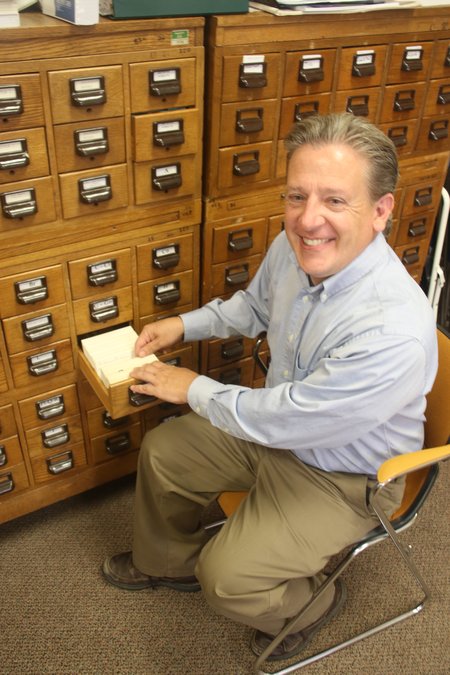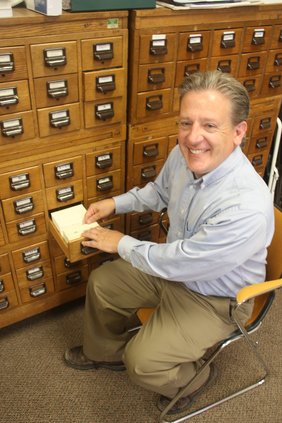

When I was in the third grade, in the basement of the local library, they had the dioramas and the local artifacts, and for some reason I was bitten by the history bug. I maintained that interest. I loved history from that point forward.-- SFTC Director Seth McFarland
LARNED — Seth McFarland likens his growing up years to a tumbleweed blowing in the wind. Even after becoming grounded in history through high school and college, he’d worked at five museums before getting the call over the summer in 2020 that the Santa Fe Trail Center in Larned was looking for a museum director.
After working seven years at the Palace of the Governors at Santa Fe, New Mexico, considered a state icon as anchor to the state’s history museum system, McFarland was ready to downsize into a more relaxed, more cozy and more flexible situation that still had connections to the Santa Fe Trail — his favorite research subject.
In his third year at SFTC, he notes he’s found that place two miles west of Larned. In addition to keeping long-standing SFTC events and programs running, he keeps busy digging into the archives. Once in a while, he finds out things he’s sure that not even the most historied local doesn’t know.
He’s currently researching the year 1923 in Pawnee County. That’s significant, because it was the year that the Pawnee County Historical Society — one of the oldest active organizations in the state — was founded. Before that time, McFarland notes, the county’s historic items were stored in basements, attics, garages and barns. Important papers were being kept at the Pawnee County Courthouse, of course, but historic knowledge includes tangible artifacts, too.
At the time the Society was founded, Fort Larned was privately owned as a ranch by the Frizell family. The Society collaborated with the family to host a museum on the site.
Time passed and Fort Larned was made a National Historic Site, so that meant the museum had to be moved, along with all the artifacts. Along the way, the Pawnee County Historical Society changed its name to Fort Larned Historical Society.
It’s that organization that the SFTC owes its allegiance to.
“This year is the actual centennial year for our historical society,” McFarland explained. “Concerned citizens banded together to preserve the pioneer history of the county. “Some records started at the courthouse, went to the library, then to the Fort. When the Fort became a historic site, the local collections needed a place to move to, and that’s why the Trail Center exists as it has since 1974.”
With the primary purpose of collection and preservation of records and artifacts in hand, a museum must evolve in its methods of presentation and, often-times overlooked, outreach, McFarland said. “Large or small, that’s the role of a museum,” he noted. “It needs to be involved with the community.
“I’m trying to encourage more participation within the community,” he said. “In annual events, helping with school events that take the museum to the classroom, and in-house events that engage community members, that gives them not only the stories, but the hand-held objects that go with them. That way it stays relevant and relatable for everybody. The mission remains Santa Fe Trail, but the pioneering history of Central Kansas and origins of Pawnee County are important.”
One such event that will involve the next meeting of the SFTC board membership is the concept of the “Pennsylvania Picnic” that used to be held and well-attended by Pawnee Countians a century ago every August.
“It started with a few ladies who realized that they had connections in coming from Pennsylvania,” he said. “They planned a picnic that just sort of grew over time. I’ve read accounts that noted there were more than 5,000 people that attended.
“We don’t do that kind of thing any more,” he said. “I’ll bet that not very many lifetime Pawnee Countians knew we used to do that.”
The “Tumbleweed years”
“Growing up, our family moved every few years, so I was kind of like a tumbleweed,” he said. “But when I was in third grade, in the basement of the local library they had the dioramas and the typical artifacts, and for some reason I was bitten by the history bug. For me, I maintained that interest. I loved history from that point forward. In high school I was joining historical clubs. When you can put your hands on the history, that makes a difference. I’m a visual and tactile learner; I like to feel the history in my hands.”
In college in Arizona and New Mexico, “my original intent for a degree was anthropology,” he said. “I started looking at a career with a larger museum that would have an archaeologist.
After college, “I had been studying land grant history in New Mexico. I got connected with the Santa Fe Trail by studying a large landowner of the period. My first job was with a small museum right on the Trail working with the Boy Scouts.
“I was fascinated with all the rugged individuals, the explorers and all of that.”
He has a diverse museum background. “I worked with the Palace of the Governors for over 7-1/2 years, at the end of the Trail that ignited more interest, with the whole experience of multi-cultures.”
He was an operations manager with the Palace, but was ready to move on. “I had my large museum, I had my large staff, but something was missing,” he said.
At the SFTC
A friend told McFarland about the SFTC position and he got in touch. He arrived about a week before the SFTC’s Tired Iron Show, which is the museum’s largest annual event. He then weathered the pandemic, with its own new challenges.
Looking ahead, McFarland wants to steer the museum toward a more active role in the community, especially with outreach programs and appearances at community events.
Like the “Pennsylvania Picnic,” there are opportunities for the community to gather, he said.
“Back then, it wasn’t just a different time, it was a different way of thinking,” he said. “A large part of that gathering mentality has been lost. We are more used to it in smaller towns.
“We’re in the center of the nation,” he said. “We are the heartbeat of America. “We’ve always been a crossroads for centuries, from migrations of indigenous cultures and still we’re seeing migrant populations today. There are people here that have been here and aren’t from here. There is a turnover, but yet Pawnee County has deep roots here. There are six generations that have been raised here.
“I’ve been a tumbleweed, and so I’ve never sunk deep roots. I’ve been around populations that go deep. We are, now, not just preserving our history but working to entice people to come back and stay. There is an innate desire to come back home. The museum needs to be involved in that, too.”
Community Connections is a regular feature of the Great Bend Tribune, showcasing people who live in the Golden Belt. We welcome readers to submit names of individuals who are active in the community that they would like to see featured in a future story. Send suggestions to news@gbtribune.com and explain their “community connections.”








